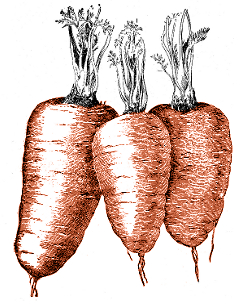Archive for the ‘Practicalities’ category
Posted in The New Garden, Planning, Practicalities on Sunday, May 9th 2021 (10.48 AM).
In the last post I mentioned that the new garden is a barren empty space, which was and is true. The previous owners had bought a patch of soggy, waterlogged and undraining grass, and had stripped it and all the topsoil off intending to Do Something With It, but never really did get anything done. Arriving with maybe a little more self-awareness, we realised we were going to have to bring in landscapers, at the very least, to help us come up with an outline layout and do much of the heavier work—the earthmoving, paving-laying, bed-building and so on. So now, a start has been made, and to hopefully make it a little less waterlogged the garden currently resembles the sort of artificial inland beach you find in The Netherlands.
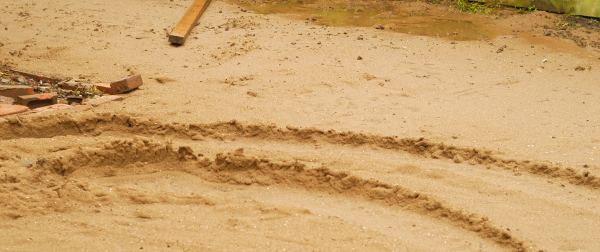
Topsoil is already on order, so hopefully before too long we will have a bare expanse of soil instead of sand. In the meantime, we’ve started buying plants to go into the beds when they are ready. Fingers crossed they won’t have to sit in their pots too long.
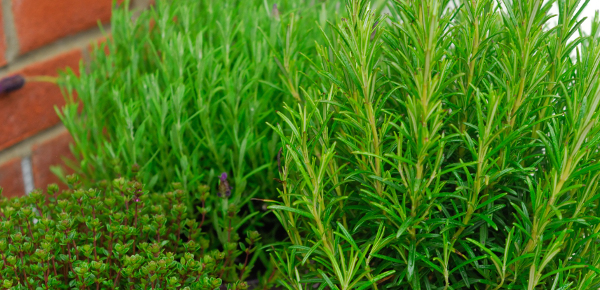
Unsurprisingly, herbs are the first thigng to be bought.
thyme, rosemary, lavender, Lavandula, Salvia rosmarinus, Rosmarinus officinalis, Thymus
Posted in Planning, Practicalities, The Old Garden In Bristol on Thursday, August 20th 2020 (7.15 PM).
When this blog first started in 2011 I drew a sketchplan of the garden and have referred back to it in posts here a few times since. It only recently occurred to me that now I have a better phone than I did then, I could get the same effect by leaning out of the bathroom window. So here is what the garden currently looks like, more or less, in yesterday’s rainstorm. Please excuse the chopped-down brambles wilting on the roof of the shed.
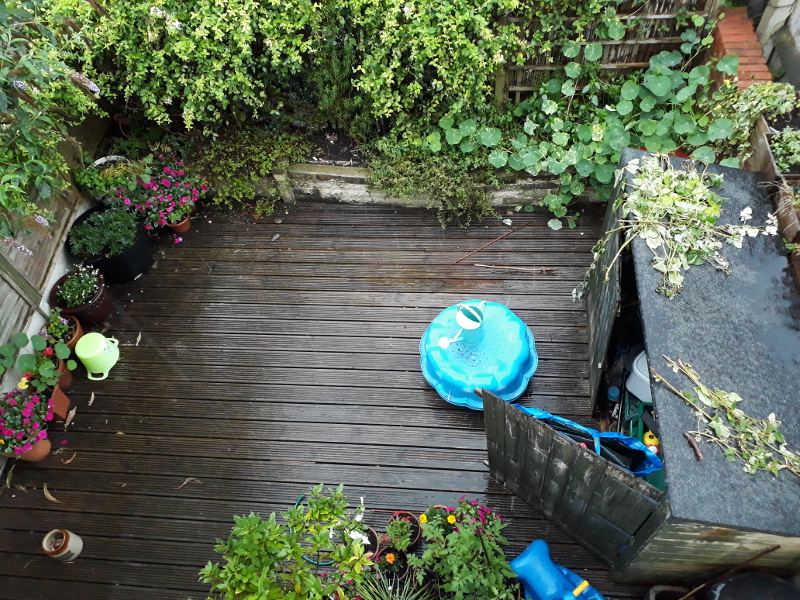
plan, overview
Posted in Experimentation, Garden Diary, Practicalities, The Old Garden In Bristol on Friday, May 27th 2016 (10.33 PM).
There haven’t been any posts here in the past month, partly because I was waiting to see if the Zierkürbis seeds would germinate. As they haven’t, I suspect it is safe to say that they were too old to grow successfully.
Not much else has been very successful in the past month, largely because the local slug and snail population has woken up to the fact that there are fresh tender new seedlings all over my garden. So, seedling after seedling has sprung up only to have its baby leaves immediately nipped off. The whole line of pea plants seemed to be doing reasonably well, until over the course of a few days last week something sluglike went eating its way along the row, a couple of plants per night. So far only one is left – ironically, one that The Child Who Likes Fairies grew by accident in the bucket of stale compost she has been given to “play digging” in.
So now, a whole new round of seed-sowing has started, this time with the idea that everything will be germinated indoors, and kept indoors overnight until it is chunky enough to survive a brief slug attack. The next round of peas will be going into containers, on the grounds that previously, when growing peas in containers, they stayed remarkably slug-free. We’ve switched pea varieties too, because the peas we were using previously had less than a 50% success rate at germinating: not great if you want to try to get back on track quickly and only have limited space to do it in.
pea, slug, snail, zierkürbis
Posted in Decorative, Experimentation, Garden Diary, Practicalities, The Old Garden In Bristol on Sunday, April 17th 2016 (9.18 PM).
This afternoon, I finished weeding the rosebay willowherb, until more shoots spring up at least. Weeded every shoot I could see, dug up every rhizome I could find, levelled out the soil and spread a layer of compost across the top.
The sowing plan for the bed starts with: peas at the back, against the trellis. Now, I’ve had issues with pea support in the past, and I suspected that the laths of the trellis are a bit big for a pea plant to wrap a tendril around, so the trellis has been covered in green plastic pea netting. It’s not the prettiest solution but it’s not too obtrusive; and I’m sure the vines of the back neighbour’s honeysuckle will love clinging onto it too.
In the front of the bed, we have scattered various seeds, mostly flowers, in the hope that the will grow up in front of the pea plants without eclipsing them entirely. We’ve scattered handfuls of:
- Cornflower, Centaurea cyanoides “Blue Diadem”
- Night scented stocks, Matthiola bicornis
- Corn marigold, Chrysanthemum segetum
- Poppy, Papaver rhoeas “Flanders”
- Swiss chard, Beta vulgaris vulgaris Cicla-Group “Five Colour Silverbeet”, because Gretchen has spotted it elsewhere and liked the different colours of the leaves.
- Tree spinach, Chenopodium giganticum “Magenta Spreen”, scattered from a packet I bought a couple of years ago and intended to sow but never did. The aim of the tree spinach is much as it was when I bought the packet: it has been sowed in the left-hand end of the bed, a dark and fairly damp corner where not much grows apart from dandelions. Tree spinach might prefer sun, but will hopefully cope with the shade there; and there won’t be any peas at that end that it might crowd out.
There are also nasturtiums, Tropaeolum majus “Empress of India”, apparently “a classic Victorian variety” according to the Internet, sowed in a couple of spots, their seeds like tiny miniature brains. The key to all of this, of course, is the idea that the peas are going to clamber up high enough and quick enough that none of the stuff around them will cause any problems. The other key, which you might have realised, is that nearly all of the ornamental (or semi-ornamental) stuff is self-seeding. Hopefully, once everything is set up, everything will keep on going year after year, or at least until we move house.
This is all very experimental and no doubt a Proper Gardener would tell us we were trying to cram far too many plants into a tiny space. However, we will wait and see. I won’t be surprised if not everything develops, or at least, doesn’t grow exactly how I originally envisaged things. It might need a bit of tweaking next year, or it might all come up again, irregular but satisfactory.
I’ve given up on the calendula seeds mentioned previously, and bought a new packet. Into pots, we sowed:
- More calendula, obviously.
- And more Tropaeolum majus.
- Mixed rocket leaves
- A different dwarf sunflower, Helianthus annuus “Choco Sun”, allegedly one of the smallest sunflower varieties available. Short enough for a toddler to sniff, I hope.
And with a general tidy-up, the garden is looking reasonable again. The back bed may be bare soil now, but hopefully within a month or two it will be full of greenery, and mostly the greenery we intended, too. In the tidy-up a lot of the wooden containers were thrown away, their wood rotted too far to save them, but that leaves us a good terracotta core. The plants we bought and potted up 2½ weeks ago are settling in nicely: the fennel looking lively, the thymes putting on new growth, and the marjoram already starting to fill up its pot. I’m rather pleased with how quickly things have been turned around. Even if things aren’t perfect yet, there’s not too much more tidying up left to do.
calendula, chard, corn marigold, cornflower, creeping thyme, fennel, french marjoram, green fennel, lemon thyme, marigold, marjoram, nasturtium, pea, poppy, rosebay willowherb, sowing, sowing plan, sunflower, swiss chard, thyme, tree spinach, weeding, Tropaeolum
Posted in Experimentation, Garden Diary, Practicalities, The Old Garden In Bristol on Thursday, April 14th 2016 (9.46 PM).
The first few pea shoots started to break the surface a couple of days ago, making it five days after sowing. Rather fast, I thought; only a few have come up so far, which makes me worry I’ve kept them too damp or something.
In the meantime I’ve been clearing out the back bed, into which the peas are going to be transplanted once large enough. A few years ago, I spent weeks clearing bindweed out of it, going through the soil archaeologically to excavate the tiniest pieces of bindweed rhizome. Now, after a couple of years of baby-rearing abandonment, it’s been colonised by rosebay willowherb. So I’m going through the soil almost archaeologically again, pulling out chunky pieces of rosebay willowherb rhizome this time. Hopefully I have got as much as possible: if I’ve missed any, once there are other plants in there the archaeological approach isn’t likely to work very well. I will have to resort to pulling up each shoot again and again until the rhizomes are exhausted.
There is still no signs of the calendula seeds we sowed twelve days ago germinating. To be honest I have no idea how long they normally take to germinate, but as I usually tend towards the impatient side, and I was always a bit skeptical that the packet would still contain viable seeds, I am suspecting that nothing is going to appear. Pushing on ahead, today we planted a pot of borage seeds (Borage officinalis) and another of poached eggs, which is hardly the nicest plant name I’ve ever come across, so I think I’ll just refer to it as Limnanthes douglasii from now on. Both pots will only really be large enough for one plant of each; a rather small plant in the borage’s case; but that will suffice. There may be just enough room for one borage plant in the back bed too, in front of the peas, but I doubt it with everything else I’d like to squeeze in there.
We did also buy a few plants from the greenhouse at St Werburghs City Farm, which sells plants as part of its horticulture training scheme for adults with special needs. A couple of chervil (Anthriscus cerefolium) and a dwarf variety of sunflower, which hopefully should grow to about the same height as the children. They were repotted this afternoon, despite a cold shower of rain, and with the children “helping” moving the compost about.
borage, calendula, chervil, germination, limnanthes douglasii, pea, rosebay willowherb, sowing, sunflower, weeding
Posted in Children, Experimentation, Garden Diary, Planning, Practicalities, The Old Garden In Bristol on Tuesday, March 29th 2016 (9.56 PM).
Spring has come around, and the brambles are slowly being hacked back. At least once a week, if the weather has been dry enough, I have been going outside, gloves on, and cutting my way into them. There aren’t many garden jobs I will wear gloves for, but demolishing brambles is one of them.
This has to be the year I get on top of the garden and get interested in it again, because the children—now aged two and a quarter—have started to take an interest in it themselves, partly because of me going out to hack the brambles down. “Me help garden!” says The Child Who Likes Fairies each time I look as if I’m about to go out there. Her “help” consists mostly of moving mud from place to place, of course; we gave her an old spoon in the hope she wouldn’t use her hands, but of course she does use her hands.
Given that the garden has been abandoned for two and a half years, more or less, not much is salvageable. One thing I have learned about keeping a largely container-based garden is that it does indeed require a lot of maintenance, because you don’t really end up creating a self-seeding ecosystem other than one based around dandelions. The bay bush that stands in an IKEA dustbin is doing just fine; the last potato crop in the other IKEA dustbin seems to have turned perennial, the foliage looking steadily less healthy each year. There is a pot of lavender which looks lively; a pot of rosemary which looks OK; and another rosemary and a purple sage which look as if they might survive, if we apply the defibrillator. Apart from that, there are a lot of pots filled with weeds or bare compost, and a goodly number of wooden containers in varied states of decay.
So, what to do? Back to basics, that’s what. Back to what we did five years ago when we decided we wanted to do something with our garden: go down to the garden centre, buy some plants, and see what we can make with them. The very first pots we bought are still in great condition, probably because they’re not just plain terracotta, so into them the plants go. Let’s see what happens.
There are a couple of tenets we’re trying to stick to this time. Firstly, we have children now, so it’s their garden too. The garden has to be safe for them to play in, have room for them to play in, and they need to be able to get involved in it. Secondly, we have much less time than we used to, so it has to be simple to maintain. We might only have a tiny garden, but we no longer have time to care for it on a square-millimetre basis. The other tenets are the same as always: organic principles as far as possible, things to be ideally productive, in some broad sense, as well as attractive, and the deliberate avoidance of neat rows and unnaturally bare soil. So the plants that have gone into pots today are:
- Lemon thyme, Thymus x citriodorus.
- Purple sage, Salvia officinalis purpurascens. Yes, even though we have one already just hanging on, and we’ve never had much success with sage previously. I am blaming our previous failures on small pots and over-watering.
- Green fennel, Foeniculum vulgare.
- French marjoram, Origanum onites.
- Creeping thyme, Thymus praecox “coccineus”. No, you can’t eat this one.
As The Child Who Likes Fairies has already shown herself highly skilled at moving soil from one place (usually pots) to another (usually the decking), we let her and her brother help repot them all. She quickly picked up the idea of moving compost from bag to pot. The Child Who Likes Animals, on the other hand, preferred to run around the garden as fast as he could, but he definitely seemed to be enjoying it too. Even when the rain started, they didn’t want to stop. “Me like rain,” TCWLF said. Next time, we might even let them plant some seeds.
back from the dead, creeping thyme, fennel, french marjoram, green fennel, herbs, lemon thyme, marjoram, purple sage, sage, summary, thyme
Posted in Garden Diary, Photobloggery, Practicalities, The Old Garden In Bristol on Monday, May 14th 2012 (10.31 PM).
Never trust anything you read, especially if it is on the back of a seed packet. “Self-supporting if sown in a block”, it says on the back of the packet of peas I’ve been sowing for the past couple of months. Self-supporting if sown in a block. Now, I admit, the pea stems aren’t exactly lying flat on the ground, but they have lurched rather drunkenly over to one side, the well-grown stems from the first batch completely swamping the later ones. I have, rather belatedly, added some string to prop everything up and get everything growing a bit more upright. I’m not too sure how these peas are doing: the first batch may have plenty of leaf and tendril, but there is no sign of any sort of flower yet.
Both batches of potatoes are well up now and have completed earthing up – the second batch with a few sprigs of leaves showing, the first batch with a good head of foliage. The leaves of this year’s variety are, initially, a beautiful deep maroon in colour.
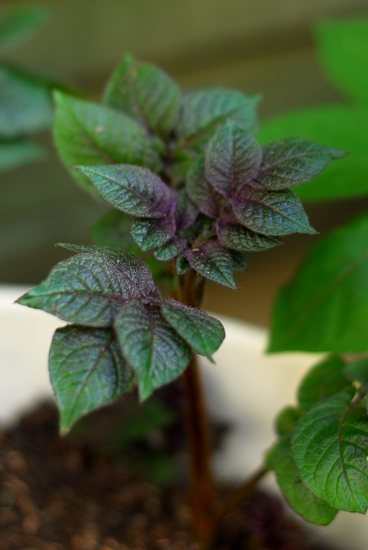
I was hoping that the plants would retain the colour as they grow. As the leaves get larger, however, they fall back to a more conventional deep green, with only the midrib and some of the larger veins keeping the red pigment. There is no sign yet, touch wood, of the leafhoppers which plagued our potatoes last year.
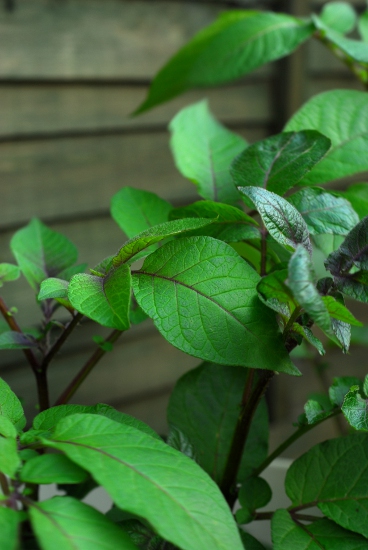
Two weeks ago, I sowed the main batch of courgette seeds, and was rather wary. We’ve not tried to grow them before, and I’ve heard stories of people having lots of trouble with them this year. However, in exactly 7 days every seed in the batch had germinated and was showing itself above the surface. I’ve killed off one as it was showing signs of rot, but the rest seem to be going well. They have started hardening up, and before they’re three weeks old should be ready for planting out.
One last thing for today: if you read Alys Fowler’s advice column in the Guardian Weekend magazine, you might have noticed last Saturday’s query about mossy containers. My mossy containers, that is: that was my letter! In particular, the container with our Swiss chard plants in, which developed a thick green carpet last autumn which didn’t seem to bother the plants at all. I shall stop worrying now that the moss might be bad for them.
courgette, pea, potato, swiss chard
Posted in Garden Diary, Photobloggery, Practicalities, The Old Garden In Bristol on Sunday, April 29th 2012 (1.59 PM).
It rained all last weekend; and since planting up the runner beans on Tuesday the rain has been essentially continuous. So I’m getting somewhat behind with the gardening, and getting more and more depressed about the state of the place. Gardening has been limited to poking the camera lens through the kitchen door, which is an angle I don’t normally try. The curly parsley decided, when the weather was hot over Easter, that it was time to bolt into flower. So far its flowers have not yet come out: maybe the rain has made it regret its decision.
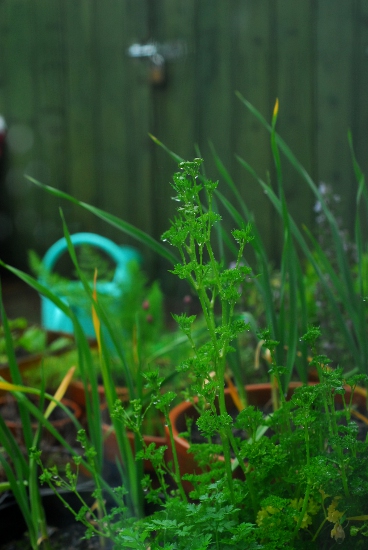
From that angle, the garden looks rather lush. It doesn’t feel that way when you’re standing in the middle of it. Moreover, the wet weather has prompted the local slugs and snails to mount a full-on attack of chewing. The garlic and fennel are too strongly-flavoured, but the runner beans and lettuces have survived a major hit, some of the pea plants are just hanging on, and a tray of coriander seedlings was completely destroyed, not a leaf left. Last night I went out twice, armed with scissors, and killed about eight slugs and five snails, stabbing the snails thoroughly and snipping the slugs in half. Well, it’s better for the rest of the garden than poison, and it definitely kills them before they can eat any more.
coriander, lettuce, parsley, pea, pest, rain, runner bean, slug, snail, spring, weather
Posted in Garden Diary, Practicalities, The Old Garden In Bristol on Wednesday, April 18th 2012 (10.20 PM).
After being lazy for far too long, this week I have finally managed to get our second batch of potatoes into the ground. Another potato bin, the same as the first, was acquired from a certain Swedish-Dutch furniture giant; its base was thoroughly perforated; and I delved into the cupboard under the stairs to find the bag of Red Duke Of York seed potatoes we bought from the Riverside over a month ago now. Unfortunately, I discovered a bit of a problem.
Some authorities on potatoes, you may already know, suggest chitting your tubers before planting. Leave them in a suitable spot, undisturbed, to get to work growing shoots, to give them a bit of a head start when they get in the ground. Other authorities say they’ve found chitting more trouble than it’s worth, because the chitted shoots are rather too prone to damage and can easily break off, leaving a potato with no more eyes and no more chance of growth. All of these authorities say that: if you do chit, plant the tubers when the shoots are about a couple of inches long.
Well, with our second batch of potatoes for this year we didn’t get any choice in the matter. Going under the stairs to find them, I discovered that they had managed to thoroughly chit themselves, all around each other and through the sides of the bag they were in, to a good six or seven inch length. Getting plantable potatoes out of the bag, without breaking the shoots off was an incredibly delicate job; and I hate to think how much I damaged them when backfilling their planting holes and firming them in. Still, most of my earthing up has already effectively been done, I suppose. It remains to be seen if any potatoes will result.
Nevertheless, the first batch of potatoes is doing well, with a good showing of richly-coloured dark maroon-green leaves coming up from at least two of the tubers. The coriander seeds I mentioned in the last post have germinated well, after about 10 days on the windowsill; and the runner beans I sowed at the same time are now all a good few inches in height. It will be tempting, if we get a warm Sunday in the next few weeks, to get my tripod out and try doing a time-lapse video of the runner bean vines coiling their way up their poles.
bean, chitting, coriander, planting, potato, runner bean, sowing
Posted in Practicalities on Sunday, February 5th 2012 (6.03 PM).
This afternoon: a seed swapping event at my favourite cinema, The Cube off King Square. I felt rather sheepish going along, because I felt I didn’t have any seeds to take. I do have seeds I’ve saved, but I have no idea at all if any of them are viable, so didn’t feel I could pass them on to the rest of the Bristol gardening community quite yet.
However, it wasn’t a wasted trip, because there was plenty to do besides swap seeds. There was a Compost Cam showing people just how entrancing worms can be to watch; there were taste tests inviting you to spot the home-grown food; and, being a cinema, there were documentary showings. I was particularly interested by one, a BBC documentary from two or three years ago, on the future of farming. In a nutshell: modern farming is doomed. Modern farming needs oil, lots of it, both for combustion engines and for chemical feedstock. As the oil industry declines, modern farming – and the entire modern food economy – will rapidly become unaffordable. All very depressing. The answer, according to the programme, is in seeing biodiversity as an essential part of food production rather than just something that gives us pretty wildlife; in designing agricultural systems which work with rather than against our natural environment; and in a move away from factory-scale agriculture towards smallholdings, because organic smallholdings, run by gardeners rather than farmers, can produce rather more food per acre than an industrial farm can. One thinks here of the Soviet Union, where despite the vast acreage of mechanised kolkhoz and sovkhoz farms, all of the quality food, and a big proportion of the staples, was cultivated on the smallholdings of kolkhoz employees in their spare time and sold in barely-tolerated private markets. Gardeners are better than farmers, it seems. Unfortunately, this is because gardeners devote much more time and attention to each square metre of land than a farmer can, and any sort of smallholding-based solution to the oncoming food supply problem will mean social change at an earth-shattering level.
The other question which comes up regularly in my mind, which the documentary reminded me of, is: just how sustainable, in the long term, is the sort of small-back-garden container gardening that I do? Because, on the face of it, it doesn’t seem to be the healthiest form of gardening. Sustainability is all about generating healthy, fertile soil, soil with its own ecosystem. The ecosystem is needed to replace everything that my plants take away, to replace everything that ends up in my dinner, and if nothing ever goes back into the soil to replace that the soil ends up dead. The general “conventional” guideline for container gardening seems to be: “use fresh compost; grow your plants; your compost is now exhausted”. That process isn’t going to build up any sort of long term sustainability.
I do have some thoughts and ideas about the above: how to make container gardening more sustainable, at the systemic level. The container garden equivalent of the medieval three-field system, maybe. This post is already well into TLDR territory, so those thoughts will come later. In other news, I just hope that the Cube do hold another event next year, when I can donate more to the proceedings myself.
bristol, farming, saving seed, seed, seed swap, sustainability



